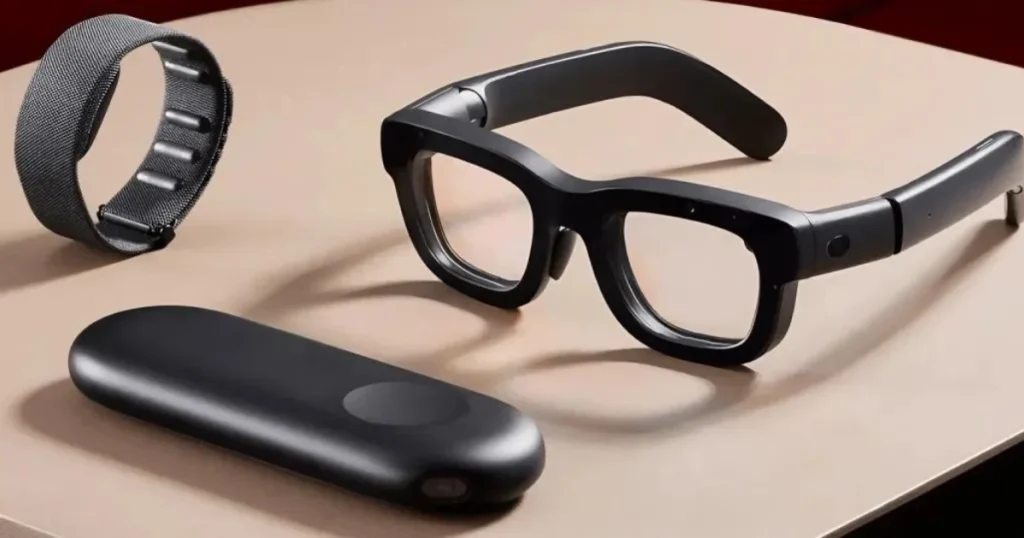
In the ever-evolving landscape of wearable technology, Meta AI has once again pushed the boundaries of innovation with their latest release: the Orion AR glasses. This groundbreaking device promises to revolutionize the way we interact with both the physical world and virtual worlds, ushering in a new era of augmented reality experiences. Hence, I have covered the features, characteristics, and challenges faced during the development of Orion in this blog and examine its potential impact on the XR industry.
Introduction to Orion: Bridging the Gap Between Reality and Virtual Worlds
Orion represents a significant leap forward in the field of augmented reality glasses. Building upon the foundation laid by previous iterations like the Ray-Ban Meta smart glasses, Orion takes AR technology to new heights. These glasses are designed to seamlessly blend the digital and physical realms, offering users an unprecedented level of connectivity and empowerment in their daily lives.
Key Features of Orion AR Glasses
1. Advanced Holographic Displays: Orion incorporates awestruck holographic display technology, capable of rendering both 2D and 3D content with stunning clarity and depth.
2. Contextual AI Integration: At the heart of Orion lies a powerful, context-aware AI system that anticipates user needs and provides relevant information in real-time.
3. Versatile Design: Engineered for both indoor and outdoor use, Orion boasts a lightweight and stylish form factor that makes it suitable for extended wear.
4. Enhanced Human-Computer Interaction: Orion AR Glasses introduces novel interaction methods, including advanced gesture recognition and the ability to interpret facial expressions.
5. Smart AI Assistant: Users can rely on a sophisticated AI assistant that learns and adapts to individual preferences and behaviors over time.
Check out the video on YouTube: Mark Zuckerberg reveals Meta’s Orion AR glasses prototype or watch below:
The Technology Behind Orion: Pushing the Boundaries of AR
Holographic Displays: A Window to New Realities
One of the most striking features of Orion AR Glasses is its advanced holographic display system. Unlike traditional AR glasses that simply overlay digital content onto the user’s field of view, Orion’s displays create the illusion of three-dimensional objects existing in the physical space around the wearer. This technology allows for the seamless integration of virtual elements into the real world, blurring the lines between what is real and what is digital.
The holographic displays in Orion AR Glasses are capable of rendering both 2D and 3D content with remarkable fidelity. Whether you are viewing a floating web browser, interacting with a virtual object, or engaging with life-size holograms of friends and colleagues, the visual experience is nothing short of breathtaking.
Contextual AI: Your Personal Digital Assistant
At the core of Orion AR Glasses functionality is its sophisticated contextual AI system. This AI is designed to understand and anticipate the user’s needs based on a variety of factors, including location, time of day, personal preferences, and current activities. By continuously learning from user behavior, the AI becomes increasingly adept at providing relevant information and assistance.
For example, when entering a grocery store, Orion AR Glasses might automatically display your shopping list, highlight items on sale, and even suggest recipes based on the ingredients you purchase. In a work setting, it could pull up relevant documents for an upcoming meeting or provide real-time language translation during international calls.
Lightweight Design: Comfort Meets Functionality
One of the greatest challenges in developing Orion AR glasses has been striking the right balance between functionality and wearability. The team at Meta AI has made significant strides in this area with Orion. Despite its powerful capabilities, Orion maintains a lightweight and comfortable design that allows for extended use throughout the day.
The glasses feature transparent lenses that look similar to regular eyewear when not in use, making them suitable for a wide range of social situations. This focus on aesthetics and comfort is crucial for the mainstream adoption of AR technology.
Advanced Interaction Methods: Beyond Touch and Voice
The Neural Wristband: A New Era of Control
The neural wristband is an essential component of Meta’s Orion AR glasses and represents a significant leap in how users interact with augmented reality. Unlike traditional input methods like touchscreens or remotes, the wristband uses electromyography (EMG) technology to interpret neural signals that control hand gestures. This translates the brain’s natural signals into precise commands, allowing users to interact with Orion in a more seamless and intuitive way.
The wristband resembles a sleek version of a Fitbit, minus the screen, and is made of high-performance textile material for comfort and durability. By reading the electrical activity in the muscles of your forearm, it interprets various gestures to control the AR interface. It’s not reading your thoughts directly, but the precision with which it translates neural signals into digital commands makes it feel remarkably close.
Gesture Control and User Feedback
One of the key strengths of the neural wristband is its ability to recognize specific hand gestures with minimal lag. For instance, pinching your index finger and thumb selects items, while pinching your middle finger and thumb opens or closes the app launcher. A unique coin-flipping gesture rubbing your thumb against your palm allows for scrolling through menus or content.
To make the user experience more immersive, the wristband provides haptic feedback when it recognizes a gesture. This tactile confirmation ensures users know their commands have been processed without needing to look down or break concentration from the AR environment. The combination of precise gesture recognition and haptic feedback creates an intuitive control experience that feels natural.
The Power of Unobtrusive Control
One of the most innovative aspects of the neural wristband is that it doesn’t need to be in direct view of the glasses’ sensors or cameras. You can control the Orion AR glasses even with your hand behind your back or inside a jacket pocket. This gives users a high degree of freedom and versatility, especially when multitasking or when your hands aren’t immediately visible. For example, you could be walking down the street or holding something in your hand while still controlling the AR interface effortlessly.
Additionally, the wristband’s interface is designed to be paired with eye-tracking technology. Your eyes serve as the pointer, and gestures like pinching fingers together function as the “click.” This dual control mechanism using both eye movement and hand gestures makes interacting with Orion much more precise than using just hand tracking, as is common with other AR devices like Meta’s Quest or Apple’s Vision Pro.
The Compute Puck: Essential to Orion’s Functionality
The compute puck is another crucial element in the functionality of Orion AR glasses. While the glasses themselves are lightweight and don’t require connection to a smartphone or laptop, they rely on the puck to function. The puck resembles a large battery pack and provides the computing power necessary for Orion’s AR experiences. Without the puck, the glasses lose their ability to operate beyond simple tasks.
The puck allows the Orion AR Glasses to function wirelessly, but its range is limited to about 12 feet. Beyond that distance, the glasses become effectively useless. This constraint means users need to keep the puck nearby for extended use, which can sometimes limit mobility. However, the trade-off is that the glasses can remain light and compact, as the computing power and battery life are offloaded to this external device. The two-hour battery life of the puck is another consideration, as it limits how long you can use Orion AR Glasses without needing to recharge.
Together, the neural wristband and compute puck provide a sophisticated yet streamlined system for interacting with Orion AR glasses, making them highly functional despite their compact size.
The Development Journey: Challenges and Breakthroughs
Miniaturization: Packing Power into a Compact Form
One of the most significant challenges faced by the Meta AI team during the development of Orion AR Glasses was miniaturization. Fitting all the necessary components – including processors, sensors, and display technology – into a form factor small enough to be worn comfortably on the face required immense engineering prowess.
The team had to develop custom chips and optimize every aspect of the hardware to reduce size and power consumption without compromising on performance. This effort involved close collaboration between hardware engineers, software developers, and industrial designers to create a cohesive and efficient system.
Expanding the Field of View: A Wider Window to AR
Another major hurdle in Orion AR glasses development has been achieving a wide field of view without making the device bulky or compromising on image quality. Orion represents a significant leap forward in this area, offering a substantially larger field of view compared to previous AR glasses.
This expanded field of view allows for more immersive experiences, such as viewing multiple multitasking windows simultaneously or enjoying big-screen entertainment without feeling constrained. The team achieved this through innovations in optics and display technology, carefully balancing factors like resolution, brightness, and power efficiency.
Perfecting the AR Display Quality: Clarity in Every Detail
Achieving high-quality AR displays that work well in various lighting conditions posed another significant challenge. The team at Meta AI invested considerable R&D efforts into developing display technology that could deliver crisp, vibrant images in both indoor and outdoor environments.
This involved tackling issues like color accuracy, contrast, and brightness while ensuring that the displays did not interfere with the user’s natural vision. The result is a display system that seamlessly blends digital content with the real world, maintaining clarity and readability in diverse settings.
Balancing Power and Battery Life: Keeping Orion Running All Day
With the ambitious goal of creating Orion AR glasses that could be worn throughout the day, power management became a critical focus area. The team had to optimize every aspect of Orion’s hardware and software to maximize energy efficiency without compromising on performance.
This involved developing new battery technologies, implementing aggressive power-saving algorithms, and carefully managing the distribution of processing tasks between the glasses and connected devices. The end result is a device that can provide rich AR experiences for extended periods on a single charge.
The Impact of Orion: Transforming Daily Life and Industries
Revolutionizing Communication: Immersive Social Experiences
Orion AR Glasses has the potential to transform the way we communicate and connect with others. Through its advanced AR capabilities, users can engage in video calls that feel more like face-to-face interactions, with life-size holograms of friends and colleagues appearing in their physical space.
These immersive social experiences blur the lines between physical and virtual presence, making long-distance communication more natural and engaging. Whether it is a business meeting, a family gathering, or a casual chat with friends, Orion brings a new level of presence and intimacy to digital interactions.
Enhancing Productivity: A New Paradigm for Work
In the professional sphere, Orion AR Glasses offers unprecedented opportunities for enhancing productivity and collaboration. With the ability to create multiple virtual screens and interact with 3D models in real space, knowledge workers can transcend the limitations of traditional computing setups.
Architects can visualize and manipulate building designs in real-time, doctors can access patient information hands-free during procedures, and engineers can collaborate on complex 3D models as if they were in the same room. The possibilities for improving workflow and decision-making across various industries are vast.
Transforming Entertainment: From Spectator to Participant
The entertainment industry stands to be revolutionized by Orion’s capabilities. Imagine watching a movie where the characters appear to be in your living room, or playing a video game where virtual elements seamlessly blend with your physical environment.
Live events and concerts could be experienced from the comfort of your home, with performers appearing as if they were right in front of you. The line between audience and participant becomes increasingly blurred, opening up new avenues for creative expression and audience engagement.
Enhancing Education and Training: Learning in Context
In the field of education and professional training, Orion offers exciting possibilities for immersive, context-rich learning experiences. Students can interact with 3D models of complex concepts, whether it is exploring the inner workings of a cell or walking through historical events.
For professional training, Orion AR Glasses can provide real-time guidance and information overlay, making it easier to learn new skills or perform complex tasks. From surgical training to industrial maintenance, the ability to access information and visualize processes in situ has the potential to dramatically improve learning outcomes and job performance.
The Future of AR: Orion as a Stepping Stone
While Orion represents a significant leap forward in AR technology, it is important to note that it is still a polished product prototype, currently being tested by Meta employees. The journey towards widely available consumer AR glasses is ongoing, with challenges remaining in areas such as further miniaturization, battery life improvement, and expanding the field of view.
However, the breakthroughs achieved with Orion provide a glimpse into the future of wearable technology and human-computer interaction. As R&D efforts continue and technology advances, we can expect to see even more remarkable developments in the XR industry.
Conclusion: A New Chapter in the AR Story
Meta AI’s Orion AR glasses represent a significant milestone in the evolution of augmented reality technology. By seamlessly blending the digital and physical worlds, Orion opens up new possibilities for how we work, communicate, learn, and entertain ourselves.
While challenges remain on the path to widespread adoption of consumer AR glasses, the innovations embodied in Orion bring us closer to a future where the boundaries between the virtual and physical worlds are increasingly blurred. As this technology continues to evolve, it has the potential to reshape our relationship with information, our environment, and each other in profound ways.
The story of Orion is not just about a new device; it is about the dawn of a new era in human-computer interaction. As we stand on the brink of this AR revolution, one thing is clear: the future is looking brighter, and more augmented, than ever before.
Here is another good read on AI and Healthcare Equity: Forging the Digital Divide.
Also check out Nova Explosions: Exploring the 8 Intriguing Factors Behind it
Citations
- Mark Zuckerberg reveals $10,000 Orion AR Glasses prototype at Meta Connect
- Mark Zuckerberg’s Meta introduces Orion augmented reality glasses: Glimpse of a future
- Meta unveils futuristic Orion AR glasses, will let users project digital on real world
- Orion AI Glasses: The Future of AR Glasses Technology | Meta
- Hands-on with Orion, Meta’s first pair of AR glasses – The Verge



Leave a Reply